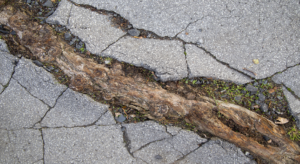
Tree Roots vs Concrete
Big, stately trees add value to your yard. Not only do they increase your home’s worth; they also provide shade, wind barriers, air filtration, habitats to wildlife and improve the overall aesthetic of your home when well cared for. Unfortunately, if your beautiful trees are planted too close to concrete, you could have issues.
As trees grow, their trunks expand, and their roots grow stronger. Most tree roots remain in the top 8 to 12 inches of soil. Although they say that roots take up about as much space as the tree itself, the truth is, a tree’s root system can be much bigger.
Some homeowners have experienced problems when their tree roots grew under their sidewalks, driveways, patios, and other concrete structures. As the roots grew concrete cracked and buckled. This can create a tripping hazard and lead to injury.
This issue is caused because the tree was planted in the wrong place. For example, we love our beautiful, stately Live Oaks, but they need a lot of room to grow. If they are planted in the small area between a sidewalk and a street curb, for instance, the roots will not have enough room to properly grow.
Signs to look for if you suspect your trees have disrupted your concrete areas:
- Cracks running across the concrete
- Roots (or bumps of earth) leading to those cracks
- Buckling in the concrete’s surface
Getting rid of roots isn’t always easy. Taking the wrong approach may be ineffective at best and harmful to your tree at worst. We always recommend consulting a certified arborist but have some remedies to consider as well.
Ways to remedy this situation:
- Install root barriers before the roots reach the concrete.
- This needs to be done when trees are young. Barriers consist of either fabric or plastic and act as an underground fence. They should be buried between the tree and sidewalk, 12 to 24 inches deep with a width of at least five feet. The barrier redirects roots to grow deep under the sidewalk, eliminating the heaving caused by roots just under concrete.
- Consider a meandering sidewalk or bridge.
- In a situation where you have the space to be creative with your concrete, consider putting a small fun bridge over your tree roots or create a meandering path like you would see in a park to preserve your tree roots.
- Cut the roots and dam them with root barriers.
- This option should be attempted with caution, as roots help a tree remain stable. If the roots are pruned, the tree may fall. Cutting too many roots or the wrong ones can kill the tree, so always contact a certified arborist.
- Remove the tree and the root system so you can make a smooth, level surface again.
- Sometimes it’s best to just remove the tree and start over. Cutting down the tree may not be enough to prevent root growth. You will also need to get rid of the stump because roots may continue to grow.
- If removal isn’t an option, look for a concrete contractor. Finding the right concrete contractor will have a big impact on the outcome of repairing or replacing your sidewalk.
Three things to avoid:
- Don’t use growth inhibitors.
- When used, energy that normally goes to the development of the tree’s crown is redirected to the root system, which will make the problem worse.
- Don’t make assumptions.
- It can be costly to replace an entire section of a sidewalk or patio. The right concrete contractor could have a solution as well.
- Don’t pave over roots.
- This can kill the tree and lead to many problems in the future. Paving over roots is like suffocating a tree. If are putting in a driveway, consider bending it away from the tree (similar to the meandering sidewalks).
Like with most problems, the real solution begins with prevention. Talk to one of our local certified arborists for more information.
Get a Quote
Looking for expert tree care? Fill out the form below and we’ll be in touch!
Looking for expert tree care?

